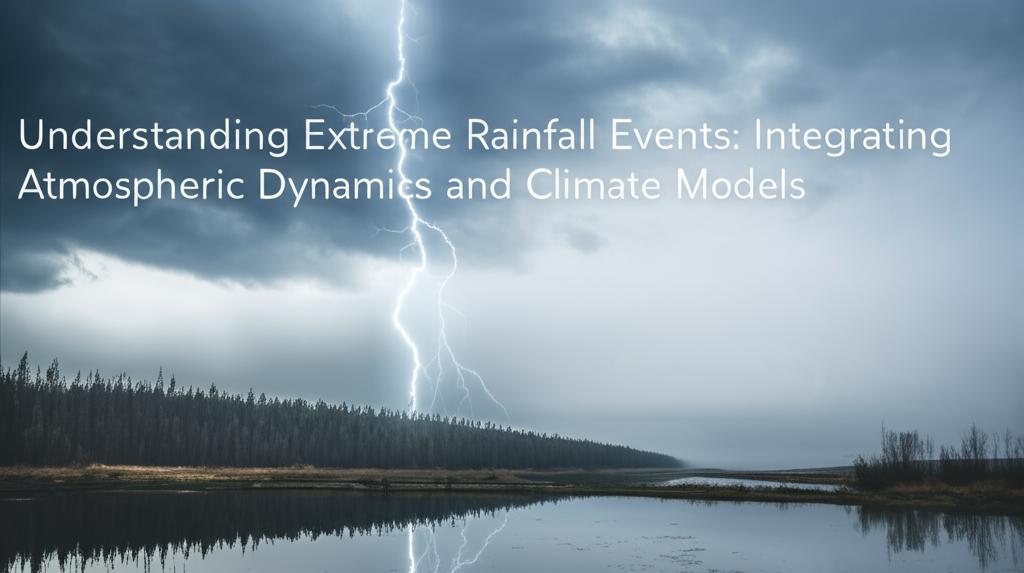Extreme rainfall events are intensifying globally, posing significant threats. Understanding the complex interplay between atmospheric dynamics and climate models is crucial for predicting and mitigating their impacts.
The Science Behind Extreme RainfallHeavy rainfall occurs when the atmosphere holds and releases large amounts of moisture. The Clausius-Clapeyron equation predicts a 6-7% increase in atmospheric moisture capacity for every 1°C of warming. However, short-duration, intense rainfall events, often associated with severe convective storms, can exceed these predictions, a phenomenon known as "super Clausius-Clapeyron" behavior. This highlights the critical role of storm dynamics.
Key atmospheric drivers of extreme rainfall include:
- Convective Storms: Supercells, with their rotating updrafts (mesocyclones), can produce extreme rainfall in short periods. Mesoscale Convective Systems (MCS), characterized by slow movement and repeated rain over the same area, can lead to prolonged flooding.
- Vertical Wind Shear: This plays a pivotal role in storm organization, influencing rainfall intensity and predictability.
- Moist Absolute Unstable Layers (MAULs): Recent research has identified a distinctive three-layered atmospheric structure critical for extreme rainfall, with MAULs sandwiched between stable upper and near-stable lower layers. This provides a new framework for understanding the thermodynamics of extreme rainfall.
- Large-Scale Atmospheric Patterns: Omega blocks and Rex Vortex couplets can create optimal conditions for sub-hourly rainfall extremes.
- Atmospheric Rivers: These narrow bands of concentrated moisture in the atmosphere can cause significant precipitation when they make landfall, particularly in areas with complex terrain. The dynamical component (winds) and thermodynamical component (integrated water vapor) of these systems influence the intensity of rainfall.
Climate models are essential tools for predicting future extreme rainfall. However, they face challenges:
- Resolution: Traditional global climate models (GCMs) often have low spatial resolution, representing large areas with a single data point. This can lead to underestimation of localized extreme rainfall events, as critical details about precipitation patterns and the influence of small-scale features like thunderstorms and complex topography may be missed.
- Convection Representation: GCMs often use "parameterization" to represent convection (the process of heat transfer in a fluid), which can limit their accuracy in simulating extreme rainfall. Convection-permitting models (CPMs), which operate at higher resolutions (kilometer-scale), can directly simulate convective processes and have shown improvement in representing moderate rainfall extremes. However, their use in long-term climate modeling is computationally expensive.
- Model Intricacies: Studies show that simply increasing model resolution doesn't consistently improve accuracy. The overall model design and how it simulates precipitation processes are crucial. Some high-resolution models show significant improvements, while others show little change or even amplified errors.
Despite the challenges, significant progress is being made:
- High-Resolution Modeling: Increased computing power is making the use of CPMs in climate prediction more viable. These models offer a promising prospect for studies on climate and climate change at local and regional scales.
- Machine Learning: Advanced machine learning algorithms, such as Long Short-Term Memory (LSTM) networks, are showing promise in improving rainfall prediction accuracy by effectively handling irregularities in rainfall data and identifying important patterns.
- Conceptual Models: New conceptual models, like the three-layered atmospheric structure associated with MAULs, are enhancing our understanding of the thermodynamics of extreme rainfall and providing pathways to better forecasting.
- Focus on Dynamics: Research increasingly emphasizes the importance of atmospheric dynamics (changes in atmospheric motion) over thermodynamics (changes in moisture content) in driving precipitation extremes in some regions. Understanding the vertical atmospheric motion is proving to be particularly significant.
- Data Integration: Combining high-resolution observational data, like radar data, with climate model outputs is crucial. Developing methods to downscale model output to resolve local events is an ongoing area of research.
- Ensemble Modeling: Using ensembles of multiple climate models helps to account for uncertainties and provide a range of potential future scenarios.
Global warming is unequivocally intensifying the hydrological cycle. Warmer air holds more moisture, leading to more intense rainfall events. Numerous studies confirm that the frequency and intensity of extreme precipitation events have increased globally and are projected to continue increasing. This leads to:
- Increased risk of pluvial (surface water) flooding.
- Greater strain on existing drainage systems.
- Significant socio-economic impacts, including threats to human lives, infrastructure, agriculture, and ecosystems.
Projections indicate that for every degree Celsius of warming, the frequency of 10-year extreme rainfall events could double, and 50-year events could triple. While the intensity of these events is also increasing, the overall change in extreme precipitation is often driven more by the increase in their frequency.
ConclusionUnderstanding and accurately predicting extreme rainfall events requires a robust integration of atmospheric dynamics within advanced climate models. While challenges remain, ongoing research into high-resolution modeling, machine learning, and the fundamental processes driving these events is leading to improved forecasting capabilities. These advancements are critical for developing effective adaptation and mitigation strategies to build resilience against the growing threat of extreme rainfall in a changing climate.

